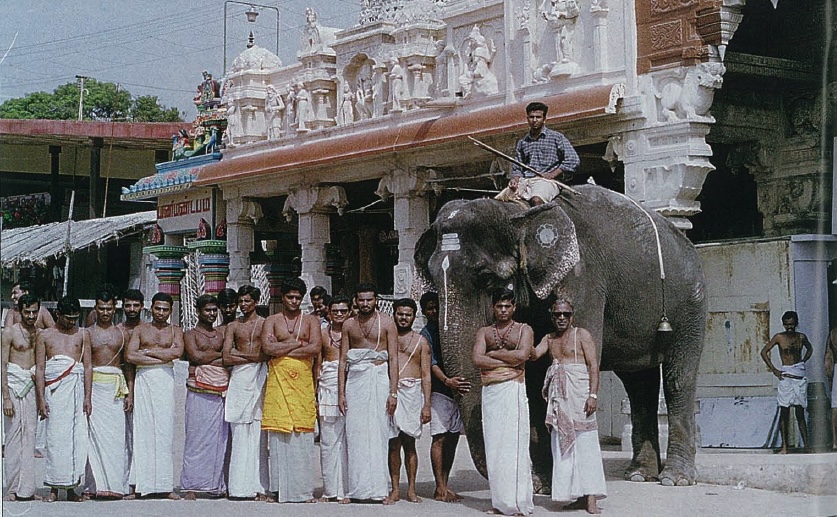With Sivakamisundari Shanmugasundaram
Kumar and his wife Sitara have just finished Tamil Nadu’s famous “Six Murugan Temple Pilgrimage.” They are physically exhausted, but their spirits soar. Years ago, they told Hinduism Today, their parents made this same sacred journey, as their grandparents and great grandparents did before them. Thousands upon thousands of Hindus have embarked upon this South Indian odyssey, on the same circuitous route followed by Kumar and Sitara. Starting from the 30,000-year-old Tiruparankundram temple near Madurai, they proceeded to the Murugan temples of Tiruchendur, Palani, Swamimalai, Tirutani and PalamutirsolaiÑin that order and without a break in continuity.
No one completing this divine excursion would ever forget it, nor would they deny that great blessings were received. Of the many Murugan temples throughout Tamil Nadu, these six are by far the most famous. Lord Murugan, “the beautiful one,” known as Lord Karttikeya in North India, is the first son of Lord Siva.
The second temple on the itinerary is Tiruchendur, a renowned pilgrimage destination in its own right. It is located in a charming town bearing the same name not far from Tirunelveli, easily located on a Tamil Nadu road map. Perched on a gentle slope by the seashore, this massive Murugan temple is uniquely captivating. Its main sanctum is actually nestled inside a cave. In the back of the cave, behind the sanctum and accessed through a narrow tunnel are five Siva Lingams, or rounded sacred stones. It is believed that Lord Murugan Himself offers prayers to these Lingams, even today, through a small hole in the top of the tunnel. Devotees assert that the hole is so sacred that though it is open to the sky, rain never drips through it into the tunnel.
The main Deity here is Murugan in the form of Balasubramaniyam. Bala means “child.” Subramaniya means “very pious.” The granite statue of Balasubramaniyam is a pious young ascetic holding flowers for worship in one hand and a rosary of sacred rudraksha beads in the other, utterly absorbed in adoration of Lord Siva.
Years ago, as legend has it, the sacred sculpture of Balasubramaniyam was stolen by Dutch invaders. But as they set sail with their booty, they were caught in a ferocious hurricane and threw the Deity overboard, either to lighten their load or out of fear they might have been cursed by their evil deeds. Soon thereafter, Lord Subramaniya appeared to the worried Tiruchendur temple priest in a dream and precisely described the spot in the sea where the icon could be retrieved. Following the instructions, devotees recovered the Deity and returned it to the temple.
In another major shrine at Tiruchendur, another form of Lord Murugan, called Shanmuganatha, is worshiped. This elegant icon is not only sacred, it is a masterpiece of art featuring Lord Murugan with six faces and twelve arms. In tribute to this particular form of the Lord, vibhuthi, or sacred holy ash, is distributed here on leaves with twelve veins depicting the Lord’s twelve hands.
The use of sandalwood is also quite famous at Tiruchendur. The temple spends about $150,000 per year on the purchase of this aromatic, yellowish heartwood. While sandalwood is a primary sacrament used abundantly in Hindu worship, doubtless no other temple in India buys as much of it as Tiruchendur does. Right on the temple premises, it is ground into paste on rough granite stones according to ancient tradition and offered to devotees as both wet and dry powder. At Tiruchendur devotees lavishly smear the cooling, aromatic sandalpaste on their face, arms and body.
Devotees throng to this temple every day, and come in droves for special festivals, especially Skanda Shasthi and Vaikasi Visakam. The temple is open from five in the morning until 10:30 at night during most of the year, with services almost always available. During the winter, worship begins at 3:00 am. The friendly temple elephant, Shanti, abides in front of the temple as a majestic, living landmark to welcome devotees with her upraised trunk.
At Murugan’s Tiruchendur abode, great miracles are said to occur in abundance. Devotees claim that the dumb are made to talk, the deaf are made to hear and acute paralysis is cured. For one and all, this ocean-side temple of magic radiates the peace that remains after all desires have been fulfilled.


